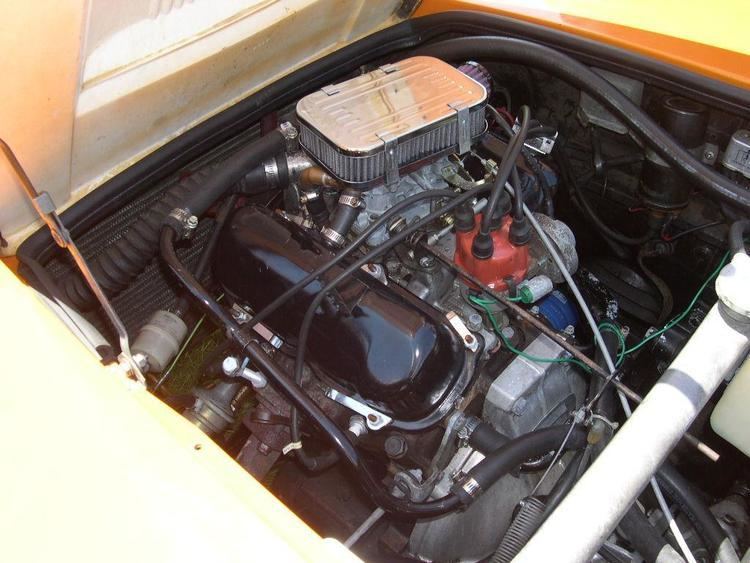Production 1962 - 1981 | Also called Taunus V4 Configuration 60° OHV V4 | |
 | ||
Displacement 1.2 L (1183 cc)1.3 L (1288 cc)1.5 L (1498 cc)1.7 L (1699 cc) Cylinder bore 1.2 L: 80 mm1.3 L: 84 mm1.5 L: 90 mm1.7 L: 90 mm | ||
The Taunus V4 was a 60° V4 piston engine with one balance shaft, introduced by Ford Motor Company in Germany in 1962. The German V4 was built in the Cologne plant and powered the Ford Taunus and German versions of the Consul, Capri and Transit.
Contents
In common with other V4 and V6 engines, but unlike longer V engines with more cylinders, the connecting rods do not share a crankpin on the crankshaft.
The V4 was later expanded into the Ford Cologne V6 engine that was used in the Ford Capri, Ford Taunus, Ford Cortina, Ford Consul, Ford Granada, Ford Sierra, Ford Scorpio, Ford Ranger, Ford Explorer, Ford Mustang, Mercury Capri, and many other cars. The V4 engine was (and still is) also used in industrial applications: pumps, electrical generators, and in agricultural machinery and snowcats. In automobiles, the Taunus V4 was replaced by the Ford OHC/Pinto engine.
Initially the V4 engine was designed by Ford for a new entry compact car intended for the US market to be called the Ford "Cardinal", which eventually evolved into the Taunus 12m P4. Ford abandoned the "Cardinal" project and instead built the Ford Falcon for North America. Ford then sought other uses for the V4 engine which was initially tested in the Saab 96. Ford bought several Saab 96s for testing and eventually sold the cars back to Saab with the V4 engines in them. Saab tested the V4s at their Trollhattan test track which stimulated Saab to acquire the V4 engine for their 95, 96, and 97 (Sonett) models starting in mid-year 1967 production. The V4 engine eliminated the need to mix oil with fuel for the two-cyle Saab "Shrike" engine and provided better low end torque. Saab dealers offered the first owner a "Lifetime Warranty" for the V4 for US$ 50.
Applications:
1.2
The 1.2 L (1183 cc) version features an 80.0 mm bore (3.15 in) and 58.86 mm (2.3 in) stroke. Output was 40 hp (29 kW) and 80 N·m (59 lb·ft) or 45 hp (33 kW) and 82 N·m (60 lb·ft).
Applications:
1.3
The 1.3 L (1288 cc) version had an 84.00 mm (3.3 in) bore and 58.86 mm (2.3 in) stroke. Output was 50 hp (37 kW) and 95 N·m (70 lb·ft) or 53 hp (39 kW) and 98 N·m (72 lb·ft).
Applications:
1.5
The 1.5 L (1498 cc) V4 had a 90.0 mm bore (3.54 in) and 58.86 mm (2.3 in) stroke. It produced 55 hp (40 kW) and 107 N·m (79 lb·ft), 60 hp (44 kW) and 114 N·m (84 lb·ft) or 65 hp (48 kW) and 117 N·m (86 lb·ft) at 2500 rpm.
Applications:
1.7
The 1.7 L (1699 cc) V4 had a 90.0 mm bore (3.54 in) and 66.8 mm (2.63 in) stroke. It produced 65 hp (48 kW) and 129 N·m (95 lb·ft), 70 hp (52 kW) and 137 N·m (101 lb·ft) or 75 hp (55 kW) and 130 N·m (96 lb·ft).
Applications:
Also, some DKW Munga, a Jeep like vehicle used in the German army were retrofitted with this Ford V4, to replace its standard two-stroke engine.
Since the engine mounts and gearbox connections are identical between the Ford Cologne V6 engine and the V4, some vintage V4 Saab 96s were modified to take a V6, for rally racing, although this dramatically changed the weight distribution and steering characteristics.
Since the Saab 96 was used for rallying it was also tuned. In the rally versions it was bored and stroked to 1784 cc and 1933 cc giving around 150 hp (110 kW) in the naturally aspirated version and 200 hp (150 kW) DIN at 7000 rpm in the Saab 96 RC Turbo version, doing 0 to 100 km/h (62 mph) in five seconds. SAAB also tuned the engine to 240 hp.
